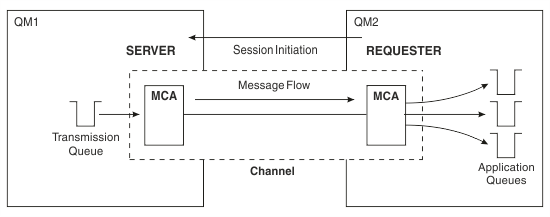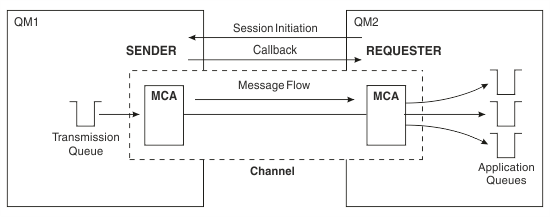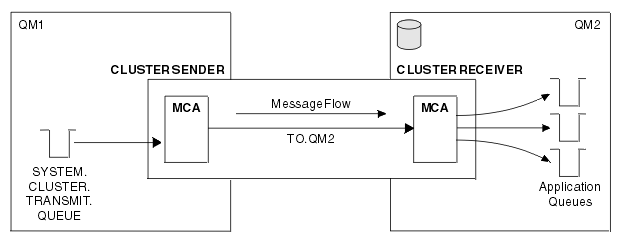Distributed queuing components
The components of distributed queuing are message channels, message channel agents, transmission queues, channel initiators and listeners, and channel-exit programs. The definition of each end of a message channel can be one of several types.
Message channels are the channels that carry messages from one queue manager to another. Do not confuse message channels with MQI channels. There are two types of MQI channel, server-connection (SVRCONN) and client-connection (CLNTCONN) . For more information, see Channels.
- Sender (SDR)
- Receiver (RCVR)
- Server (SVR)
- Requester (RQSTR)
- Cluster sender (CLUSSDR)
- Cluster receiver (CLUSRCVR)
- Sender-receiver
- Requester-server
- Requester-sender (callback)
- Server-receiver
- Cluster sender-cluster receiver
Detailed instructions for creating a sender-receiver channel are included in Defining the channels. For examples of the parameters needed to set up sender-receiver channels, see Example configuration information applicable to your platform. For the parameters needed to define a channel of any type, see DEFINE CHANNEL.
Sender-receiver channels

Requester-server channels
A requester in one system starts the channel so that it can receive messages from the other system. The requester requests the server at the other end of the channel to start. The server sends messages to the requester from the transmission queue defined in its channel definition.

Requester-sender channels

Server-receiver channels
This is like sender-receiver but applies only to fully qualified servers, that is server channels that have the connection name of the partner specified in the channel definition. Channel startup must be initiated at the server end of the link. The illustration of this is like the illustration in Figure 1.
Cluster-sender channels

Cluster-receiver channels
In a cluster, each queue manager has a cluster-receiver channel on which it can receive messages and information about the cluster. The illustration of this is like the illustration in Figure 4.